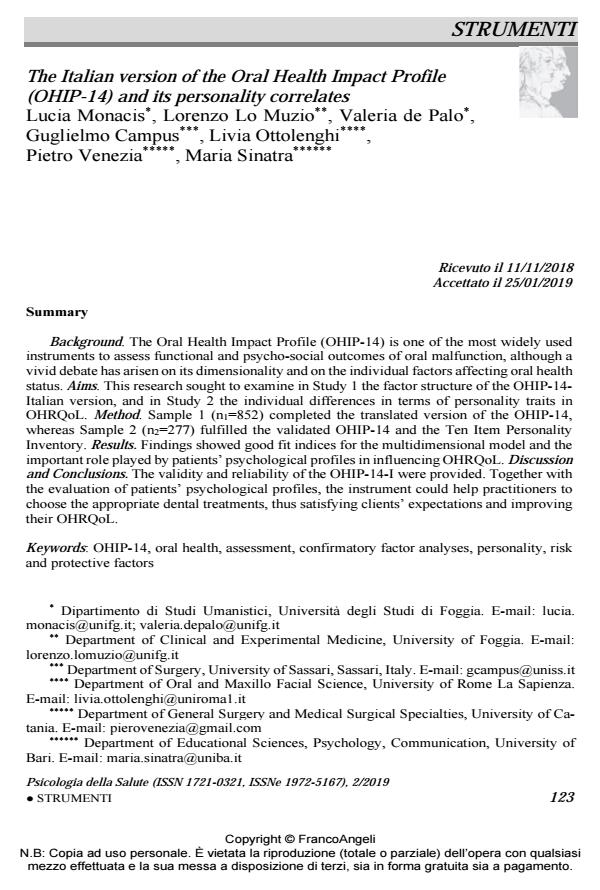The Italian version of the Oral Health Impact Profile (OHIP-14) and its personality correlates
Titolo Rivista PSICOLOGIA DELLA SALUTE
Autori/Curatori Lucia Monacis, Lorenzo Lo Muzio, Valeria de Palo, Guglielmo Campus, Livia Ottolenghi, Pietro Venezia, Maria Sinatra
Anno di pubblicazione 2019 Fascicolo 2019/2
Lingua Inglese Numero pagine 20 P. 123-142 Dimensione file 420 KB
DOI 10.3280/PDS2019-002006
Il DOI è il codice a barre della proprietà intellettuale: per saperne di più
clicca qui
Qui sotto puoi vedere in anteprima la prima pagina di questo articolo.
Se questo articolo ti interessa, lo puoi acquistare (e scaricare in formato pdf) seguendo le facili indicazioni per acquistare il download credit. Acquista Download Credits per scaricare questo Articolo in formato PDF

FrancoAngeli è membro della Publishers International Linking Association, Inc (PILA)associazione indipendente e non profit per facilitare (attraverso i servizi tecnologici implementati da CrossRef.org) l’accesso degli studiosi ai contenuti digitali nelle pubblicazioni professionali e scientifiche
Background. The Oral Health Impact Profile (OHIP-14) is one of the most widely used instruments to assess functional and psycho-social outcomes of oral malfunction, although a vivid debate has arisen on its dimensionality and on the individual factors affecting oral health status. Aims. This research sought to examine in Study 1 the factor structure of the OHIP-14-Italian version, and in Study 2 the individual differences in terms of personality traits in OHRQoL. Method. Sample 1 (n1=852) completed the translated version of the OHIP-14, whereas Sample 2 (n2=277) fulfilled the validated OHIP-14 and the Ten Item Personality In-ventory. Results. Findings showed good fit indices for the multidimensional model and the important role played by patients’ psychological profiles in influencing OHRQoL. Discussion and Conclusions. The validity and reliability of the OHIP-14-I were provided. Together with the evaluation of patients’ psychological profiles, the instrument could help practitioners to choose the appropriate dental treatments, thus satisfying clients’ expectations and improving their OHRQoL.
Introduzione. L’Oral Health Impact Profile (OHIP-14) è uno degli strumenti più utilizzati per valutare gli aspetti funzionali e psicosociali del malfunzionamento del cavo orale, sebbene la sua struttura dimensionale e i fattori individuali che influenzano la salute orale sono ancora oggetto di dibattito. Scopi. La ricerca intende esaminare la struttura fattoriale della versione italiana dell’OHIP-14 (Studio 1) e le differenze individuali in termini di tratti di personalità che influenzano la qualità di vita associata alla salute orale (Studio 2). Metodo. Due campioni sono stati reclutati dalle cliniche dentali. Il primo campione (n1=852) ha compilato la versione italia-na dello strumento, mentre il secondo campione (n2=277) ha compilato la versione validata dell’OHIP-14 e il questionario sulla personalità. Risultati. Sono emersi buoni indici di adatta-mento del modello multidimensionale e il ruolo importante dei tratti di personalità nel predire la qualità di vita associata alla salute orale. Discussione e conclusioni. Sono state confermate la validità e l’affidabilità dello strumento OHIP-14. Unito alla valutazione del profilo psicologico dei pazienti, lo strumento potrebbe aiutare gli odontoiatri a pianificare trattamenti appropriati in modo da soddisfare le aspettative dei pazienti migliorando la qualità della vita associata alla salute orale.
Parole chiave:OHIP-14, salute orale, assessment, analisi fattoriale confermativa, personalità, fattori di rischio e di protezione
- Exploring the Mediating Role of Oral Health between Personality Traits and the Psychosocial Impact of Dental Aesthetics among Healthy Older People Lucia Monacis, Lorenzo Lo Muzio, Santo Di Nuovo, Maria Sinatra, Valeria de Palo, in Ageing International /2020 pp.18
DOI: 10.1007/s12126-019-09358-6
Lucia Monacis, Lorenzo Lo Muzio, Valeria de Palo, Guglielmo Campus, Livia Ottolenghi, Pietro Venezia, Maria Sinatra, The Italian version of the Oral Health Impact Profile (OHIP-14) and its personality correlates in "PSICOLOGIA DELLA SALUTE" 2/2019, pp 123-142, DOI: 10.3280/PDS2019-002006